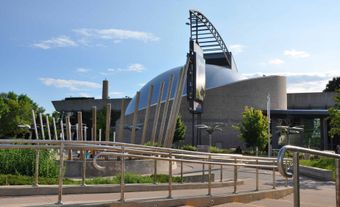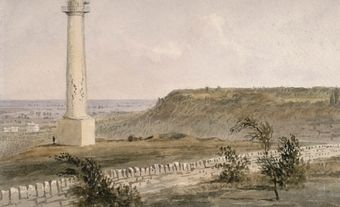Montréal’s Rio Tinto Alcan Planetarium is part of the Space for Life complex, which includes Montréal’s Biodome, Insectarium and Botanical Gardens. Space for Life is the largest natural science museum complex in Canada.
The Dow Planetarium (1966–2011)
In 1962, Dr. Pierre Gendron, chemistry professor, founding dean of the Faculty of Science at the University of Ottawa and astronomy enthusiast, devised a plan to build a planetarium of international calibre in Montréal for Expo 67. As a member of the board of directors of Dow Brewery (which became the O’Keefe Brewery in 1967 and is now owned by the Molson Coors Brewing Company), Gendron convinced Dow to invest in the venture, making his plans a reality.

The Dow Planetarium was unveiled on 1 April 1966, by then-mayor of Montréal, Jean Drapeau. Built at a cost of $1.2 million, the Planetarium was designed by the architectural firm David, Barott & Boulva, which also collaborated on the Habitat 67 project. The building’s modern design stood out with its dome resembling Saturn and its rings. Inside, the biggest attraction was a half-million-dollar projection system with seven motors and 150 projectors, considered state of the art at the time. This projection system would contribute to the Planetarium’s success for years to come. The German-made Zeiss Projector simulated a starry sky, with its constellations and planetary movements, in real time. It also served as a time machine, projecting images of the sky at different points in history.
Forty-five years later, on 10 October 2011, Montréal’s Planetarium shut its doors after receiving over six million visitors. When it was first built, there were no more than 30 planetariums worldwide. The Dow Planetarium distinguished itself over the years and became a leading institution in scientific museology. It was the first planetarium in Canada.
The Rio Tinto Alcan Planetarium
Plans for the new planetarium began in 2007. In collaboration with the municipal, provincial and federal governments, Rio Tinto Alcan (see Alcan Aluminum Limited), a global leader in the aluminum industry, became a partner in the project, which was valued at tens of millions of dollars. The plan was to bring together all of the Space for Life institutions — Montréal’s Planetarium, Biodome, Insectarium and Botanical Gardens — on one site. An international architectural design competition was held in the spring of 2009 and the firm Cardin + Ramirez & Associés was chosen to undertake the project.

Unveiled on 4 April 2013, the new planetarium cost $48 million. With a total area of 8,000 m², the building is comprised of two giant domes, one dedicated to day and the other to night. Inside, visitors can enjoy the immersive experiences offered by the Planetarium’s two theatres. The first is scientific, the second artistic.
The Milky Way Theatre offers a two-part show. The first is a projection of the night sky with commentary by an astronomer, which changes daily. The second is a simulated voyage onboard a spacecraft, which enables visitors to marvel at the 336,332 stars of the Milky Way and to discover other galaxies.

The Chaos Theatre shows Continuum, a multimedia experience that approaches astronomy from an artistic perspective. The show takes visitors on an emotional roller coaster, bringing them to the far reaches of the universe. Using photographs taken by NASA, the film simulates the feeling of orbiting around the sun. Visitors can also take a moment to admire a calm night sky in the countryside.
In addition, three auditoriums give visitors the chance to get to know the tools used by astronomers, where visitors can control a simulated spacecraft flight or a motorized probe on Mars. The exhibit “Exo: Our Search for Life in the Universe” is a collection of meteorites and fossils and highlights astrobiology.
The Planetarium’s Architectural Heritage
The Rio Tinto Alcan Planetarium boasts a highly creative architectural design that integrates the latest energy efficiency features. With irregular shapes, enormous conical structures that point skyward, and a mostly aluminum structure (chosen because the material is versatile, durable and recyclable), the Planetarium is one of the most awe-inspiring architectural achievements that Montréal has seen in decades.
Thanks to a citizen mobilization effort led by Heritage Montréal, the old Planetarium was repurposed. On 14 March 2013, the City of Montréal announced that the Dow Planetarium would be donated to Université du Québec’s École de technologie supérieure.

 Share on Facebook
Share on Facebook Share on X
Share on X Share by Email
Share by Email Share on Google Classroom
Share on Google Classroom


